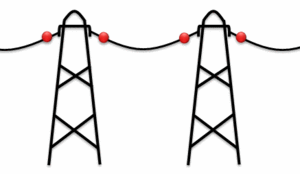- Conductor marking lights
-
Conductor marking lights are a particular type of non-standard aircraft warning lights designed for overhead power lines.
Contents
Background
Power distribution on overhead wires, often suspended to widely spaced masts, represents an almost invisible obstacle to low flying aircraft, requiring the installation of warning beacons on the masts themselves. A simple and cost effective solution to this problem is installing the marking lights directly on the wires. Nevertheless there are significant technical difficulties to a low-cost extraction of power from a distribution system which carries high voltages and wide range AC current. Moreover the warning system should not add to the existing power distribution lines the burden of additional cabling, with its potential serious isolation problems. These facts rule out the recourse to conventionally powered light sources.
Implementation principles
The ideal warning light must be able to power itself while clamped to a single wire of the line. Two approaches are, then, possible for facing this problem:
- extracting energy from the Electric Field surrounding the power line;
- extracting energy from the Magnetic Field surrounding one of the power line wires.
The first approach takes advantage of the high electric potential gradient between conductors, but a strong enough capacitive coupling is requested to allow capacitive extraction of the power required from the warning light. This means that long conductors must be suspended parallel to the line using glass/ceramic isolators: in fact several meters of suspended conductor are generally required, total length being inversely proportional to the line voltage.
The second approach is based on Faraday's law of induction involving magnetic flux flowing through a circuit which powers the warning light.Inductive coupling device
This beacon is based on the second approach described in the previous paragraph: it's powered by magnetic field surrounding the power distribution wire and uses an electronic circuit integrated in a compact clamp-on warning light.
The operating principle is very simple; basically the circuit powering this type of warning light is based on Rogowski coil principle and can be thought as a current transformer. This solution is usually intended for medium and high voltage lines up to 440 kV. However inductive coupling devices are able to work on any AC at 50 Hz or 60 Hz, from 15 up to 2.000 Amps.External links
Categories:- Electric power infrastructure
- Aviation lights
Wikimedia Foundation. 2010.


